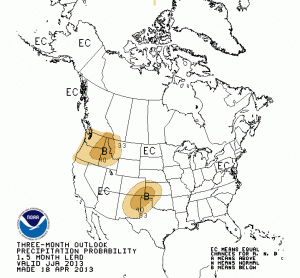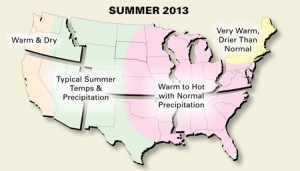A lot of sun time.
Blue sky above the KOIN Tower (shown here).
And warm weather most of the time.
Uh, most years, this would describe anywhere but the Pacific Northwest, including Portland and the Willamette Valley.
But so far, Spring 2013 has been unusually dry and warm. And that overall trend may take us right into a hot & dry northwest summer.
 See the brown colors? Those are the places that NOAA seasonal forecasters expect to be unusually dry through August 2013. The majority of the brown on this map is in the northwest!
See the brown colors? Those are the places that NOAA seasonal forecasters expect to be unusually dry through August 2013. The majority of the brown on this map is in the northwest!
 Our friends at the Farmers Almanac used their secret formula to come up with a smilar result–the northwest will be warmer & drier than usual this summer.
Our friends at the Farmers Almanac used their secret formula to come up with a smilar result–the northwest will be warmer & drier than usual this summer.
And then there’s a company called WSI. Maybe you’ve never heard of them–but I work with their hardware & software every night to build the weather graphics and images you see during my weather. Part of the company serves energy traders and utilities. And here’s what the company is telling them about spring and summer:
In May, WSI sees the monthly breakdown as:
Northeast* – Cooler than normal
Southeast* – Warmer than normal
North Central * – Warmer than normal
South Central* – Warmer than normal
Northwest* – Warmer than normal
Southwest* – Warmer than normalities with long term forecasts.
In June, WSI forecasts:
Northeast – Warmer than normal
Southeast – Warmer than normal
North Central – Cooler than normal
South Central – Warmer than normal
Northwest – Warmer than normal
Southwest – Warmer than normal
Flemming added: “Western U.S. temperatures are projected to be much warmer than normal and could lead to a strong start to summer in ERCOT and California. We expect that western natural gas demand will be stronger to support cooling demand from the power sector.
In July, WSI forecasts:
Northeast – Cooler than normal
Southeast – Warmer than normal
North Central – Warmer than normal
South Central – Warmer than normal
Northwest – Warmer than normal
Southwest – Warmer than normal
Flemming: “The outlook for cooler temperatures in the Northeast in July breaks the trend toward warmer summer temperatures over the past few years. With a much lower likelihood of summer heat events, Northeast market heat rates will come in lower than expected. Likewise, natural gas demand will be correspondingly lower due to lower power sector demand for cooling. The Southwest markets are forecast to have much warmer-than-normal temperatures and are more likely to see heat events and volatile energy prices during July.


What a great forecast! Let’s just hope it doesn’t suddenly change in August!
“Unusually warm spring” so far? Ummm…March 2013 at PDX was less than 1/2 degree above the 30-year climo, and April was almost exactly climo. If that’s your idea of an “unusually warm spring,” then how would you classify 1992 or 2004?
Bruce,
I watch your weather during the 5:30 p.m. time period because it fits my time schedule, but I have a complaint. Apparently the only part of the state that matters is Portland. You give the predicted weather for Portland and part of western OR, but what about the Gorge, Mt. Hood and eastern OR? Are we not important? It appears not. I know the standard answer is that “I”m only allowed so many minutes” but that doesn’t work. Due to my schedule I can’t watch the 6 p.m. or 11 p.m. newscasts, and I feel cheated. Please start giving the forecast for the whole state as you used to do. It at least gives the perception that the only part of OR that matters is Portland the way you present the forecast now. When you are gone and others do the weather they’re able to do the whole state, so how come you don’t seem to be able to do the same?